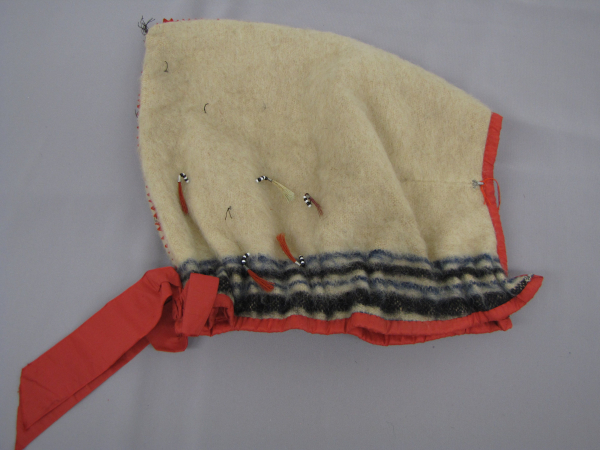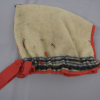hood
hood
hood





This hood is part of a child's winter outfit, probably made by the Huron-Wendat community of Lorette (Wendake). Part of a matching set with trousers and a coat, also in the collection. The outfit was originally from the collection of the Musée de la Marine du Louvre.
MQB catalogue and style.
MQB library and archives.
deStecher, Annette. Engaged Histories: Wendat Women’s Souvenir Artsof Cultural Preservation and Entrepreneurial Invention. PhD dissertation. Ottawa: Carleton University, 2013.Museum Catalogue, dissertation research, Anne de Stecher.MQB catalogue and archives.
Read More About This Relative
Wool, white, with black and blue stripes; silk, red; beads, black, white; moosehair, red; metal cones.
The hood is made of two pieces joined at one seam. There are darts on either side of the opening for the face, to make a snug fit.
There are cones with red moosehair, attached with thread decorated with black and white beads.
Stylistic, some of the dyes used for the moosehair look like aniline, which would put it after 1858.
Provenance
The Musée de la Marine originated in the seventeenth century as a collection of models of French ships, within the tradition of cabinets of curiosity and also with a teaching purpose for engineers and builders. A description of the models in the collection in 1756 included bark canoes from Canada. In 1827 Charles X. initiated the Musée de la Marine at the Louvre. Sailors, officers, and scientists of the French Marine, who sailed to all parts of the world, continued to bring back objects found in their travels to give to the King. Nineteenth century accounts of the model collection mention ethnographic works located with it. These works were transferred to the Musée d’archeologie nationale at the Château St. Jean Marlay, and then in 1909 they were moved to the Musée d'ethnographie du Trocadéro. From there they went to the Musée de l’Homme (Amérique), and then to the Musée du quai Branly. Given the early beginnings of the collection of the Musée de la Marine, ethnographic works from this collection could date from an early period of French presence in North America.A.deS.
About This GRASAC Record
Unknown artist, hood. Currently in the Musée du quai Branly, 71.1909.19.162.1. Item photographed and described as part of a GRASAC research trip; GRASAC item id 1415.
This record was created by Anne de Stecher during an RAship for Prof. Ruth Phillips.
This record will be unrestricted access on the completion of Anne de Stecher's dissertation.
46.869279102, -71.347896113
MQB catalogue and style
 Knowledge Sharing Platform
Knowledge Sharing Platform




